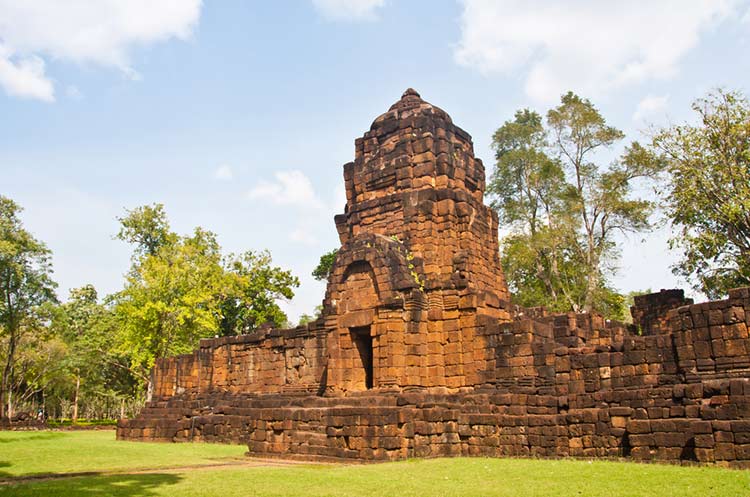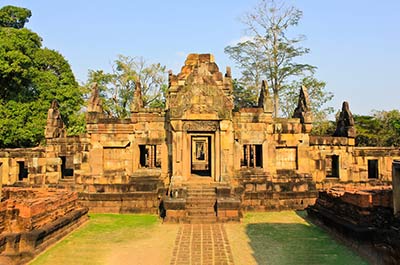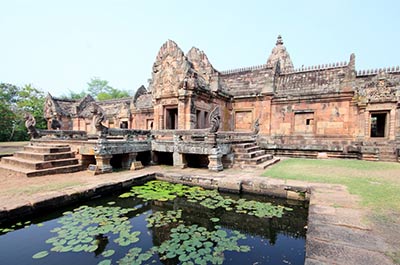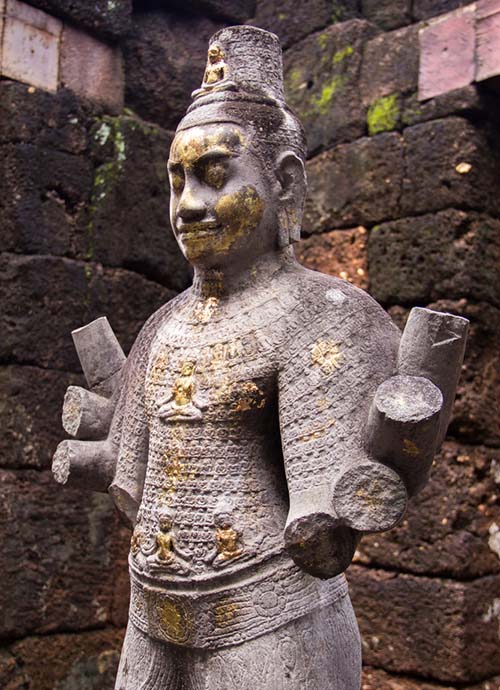
Prasat Muang Singh
Western most Khmer temple in Thailand
Muang Singh historical park marked the Western border of the Khmer in Thailand. At the height of its power, the vast Khmer empire stretched out all the way West to deep into present day Kanchanaburi province in the Western part of Thailand.
Military stronghold
Besides being a temple dedicated to the Hindu God Shiva, Prasat Muang Singh and surrounding town most likely served as a military stronghold, to defend the Khmer empire from attacks from the West.
Muang Singh, meaning “Lion city”, is completely surrounded by a laterite wall. The Khwae Noi river runs along the South end of the complex.
Bayon style
The main temple that stands in the center of the complex was built between the 12th and 14th century in Bayon style, named after the Bayon temple in Angkor that was built around the same time.


4 Day Northeast Thailand Heritage and Temples Tour from Bangkok
- Private 4 day tour with English speaking guide
- Temple of the Buddha footprint
- Khao Yai National Park
- Phimai, the largest Khmer temple in Thailand
- Hilltop Phanom Rung Khmer temple and 1,000 year old Muang Tum Khmer temple
- Prasat Sikhoraphum Khmer temple
- Prasat Wat Sa Kamphaeng Yai and Prasat Wat Sa Kamphaeng Noi Khmer temples near Laos border
- Ban Kan Lueang Iron Age Site
Structures at Muang Singh historical park
In Khmer temple architecture, the central prang (Khmer style tower) in the inner sanctuary represents Mount Meru, the center of the universe in Hindu belief. The central prang enshrines the linga, the sacred symbol symbolizing the power of Shiva. Of another large temple, only the foundation remains.
The historical park contains two other, smaller Khmer structures.
Attractive setting
Although Muang Singh is not nearly as impressive as well preserved as other Khmer temples like Phimai or Phanom Rung, it is well worth a visit. The historical park is set in a very attractive, relaxed setting with forests and the Khwae Noi river running past it.
Small museum
There is a small museum that exhibits several artifacts discovered at the site, including a number of Buddha images.

Muang Singh in recent history
During the reign of King Rama I, the first King of the Rattanakosin era at the end of the 18th century, Muang Singh acted as a stronghold to protect the Kingdom from invasion from the West.
In 1974 the Thai Fine Arts Department started renovation of Muang Singh, that was mostly covered by soil and overgrown by vegetation by then. After completion of the renovation in 1987, Prasat Muang Singh was made into a national historical park.
Ban Kao National Museum
About eight kilometers from Prasat Muang Singh is the Ban Kao National Museum. This museum built at the site of a Neolithic burial site displays items found there, such as earthenware pots, skeletons, axes, stone tools and other thousands of years old items discovered at the site.
Location
Prasat Muang Singh is located in Kanchanaburi province, some 40 kilometers West of the provincial capital Kanchanaburi town.
How to get there
Using public transportation, the best way to get to Muang Singh is to take a train to Tha Kilen station, which is about one kilometer from the historical park.
There are two daily trains from Bangkok to Tha Kilen, that take around four hours. This train does not depart from Bangkok’s main station Hua Lamphong, but from Thonburi station on the West side of the Chao Phraya river. Thonburi railway station can be reached by taking a Chao Phraya river express boat to Wang Lang pier from Tha Chang pier, at the Northern end of the Grand Palace complex. From Wang Lang pier, the train station is about one kilometers to the Northwest. This train also stops at the famous River Kwai bridge.
Opening hours
Prasat Muang Singh historical park opens daily from 8 am until 4 pm.
Entrance fee
Admission charged at the ticket booth is (Thai Baht):
Other Khmer temples across Thailand
- Muang Tum
- Phanom Rung
- Phimai
- Prasat Sikhoraphum
- Sdok Kok Thom
- Phra Prang Sam Yot
- Wat Kamphaeng Laeng
Also read


Ancient Khmer temples of Thailand
- Visit the ancient Khmer temples of Thailand
- Private or group tours
- One day or multiple days
- English speaking guide
Ancient Khmer Temples